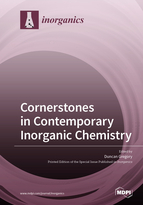Cornerstones in Contemporary Inorganic Chemistry
A special issue of Inorganics (ISSN 2304-6740).
Deadline for manuscript submissions: closed (31 March 2022) | Viewed by 57362
Special Issue Editor
Interests: nitrides; chalcogenides; carbides; hydrides; synthesis; structure; solid-state chemistry; materials chemistry
Special Issues, Collections and Topics in MDPI journals
Special Issue Information
Dear Colleagues,
This issue marks a key stage in the continued evolution of Inorganics as the go-to open access journal of cutting-edge inorganic chemistry. This Special Issue of Inorganics entitled “Cornerstones in Contemporary Inorganic Chemistry” will compile feature articles from some of the most influential and pioneering international leaders and rising lights in their respective areas of inorganic chemistry. This Special Issue will collate comprehensive and inspiring reviews and opinion pieces reflecting the current state of the art and projecting into the near and far horizons of all reaches of the discipline. The issue will provide instructive and stimulating articles that will be of lasting interest and relevance across both established and emerging fields of inorganic chemistry. “Cornerstones in Contemporary Inorganic Chemistry” will cover timely and important topics from among main group, d-block, and f-block molecular and coordination chemistry through supramolecular and organometallic chemistry to bioinorganic chemistry, inorganic medicinal chemistry, solid-state chemistry, and catalysis. These commentaries will act as references for the gamut of inorganic chemists from aspiring undergraduates to senior researchers and teachers.
Prof. Dr. Duncan Gregory
Guest Editor
Manuscript Submission Information
Manuscripts should be submitted online at www.mdpi.com by registering and logging in to this website. Once you are registered, click here to go to the submission form. Manuscripts can be submitted until the deadline. All submissions that pass pre-check are peer-reviewed. Accepted papers will be published continuously in the journal (as soon as accepted) and will be listed together on the special issue website. Research articles, review articles as well as short communications are invited. For planned papers, a title and short abstract (about 100 words) can be sent to the Editorial Office for announcement on this website.
Submitted manuscripts should not have been published previously, nor be under consideration for publication elsewhere (except conference proceedings papers). All manuscripts are thoroughly refereed through a single-blind peer-review process. A guide for authors and other relevant information for submission of manuscripts is available on the Instructions for Authors page. Inorganics is an international peer-reviewed open access monthly journal published by MDPI.
Please visit the Instructions for Authors page before submitting a manuscript. The Article Processing Charge (APC) for publication in this open access journal is 2700 CHF (Swiss Francs). Submitted papers should be well formatted and use good English. Authors may use MDPI's English editing service prior to publication or during author revisions.
Keywords
- Review
- Opinion piece
- Tutorial
- Primer
- Concepts
- Techniques
- Synthesis
- Structure
- Bonding
- Reactivity
- Activity
- Chemical Properties
- Physical Properties
- Applications






